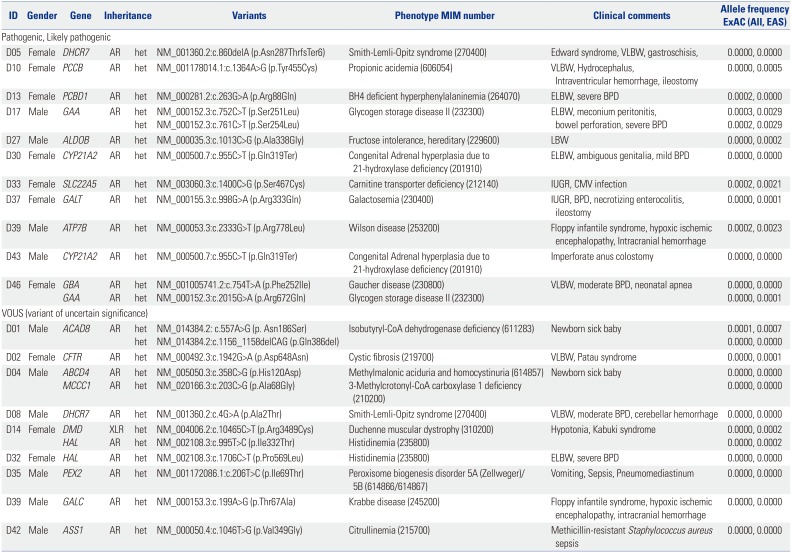1. Berry SA. Newborn screening. Clin Perinatol. 2015; 42:441–453. PMID:
26042913.

2. Therrell BL, Padilla CD, Loeber JG, Kneisser I, Saadallah A, Borrajo GJ, et al. Current status of newborn screening worldwide: 2015. Semin Perinatol. 2015; 39:171–187. PMID:
25979780.

3. Bhattacharjee A, Sokolsky T, Wyman SK, Reese MG, Puffenberger E, Strauss K, et al. Development of DNA confirmatory and high-risk diagnostic testing for newborns using targeted next-generation DNA sequencing. Genet Med. 2015; 17:337–347. PMID:
25255367.

4. Bodian DL, Klein E, Iyer RK, Wong WS, Kothiyal P, Stauffer D, et al. Utility of whole-genome sequencing for detection of newborn screening disorders in a population cohort of 1,696 neonates. Genet Med. 2016; 18:221–230. PMID:
26334177.

5. Miller J, Tuerck J, Awad K, Chace DH, Copeland S, Rasmussen SA, et al. Newborn screening for preterm, low birth weight, and sick newborns; approved guideline. CLSI document I/LA31-A. 1st ed. Wayne (PA): Clinical and Laboratory Standards Institute;2009.
6. Morris M, Fischer K, Leydiker K, Elliott L, Newby J, Abdenur JE. Reduction in newborn screening metabolic false-positive results following a new collection protocol. Genet Med. 2014; 16:477–483. PMID:
24177054.

7. Saunders CJ, Miller NA, Soden SE, Dinwiddie DL, Noll A, Alnadi NA, et al. Rapid whole-genome sequencing for genetic disease diagnosis in neonatal intensive care units. Sci Transl Med. 2012; 4:154ra135.

8. Lalani SR. Current genetic testing tools in Neonatal Medicine. Pediatr Neonatol. 2017; 58:111–121. PMID:
28277305.

9. Holm IA, Agrawal PB, Ceyhan-Birsoy O, Christensen KD, Fayer S, Frankel LA, et al. The BabySeq project: implementing genomic sequencing in newborns. BMC Pediatr. 2018; 18:225. PMID:
29986673.

10. Ceyhan-Birsoy O, Murry JB, Machini K, Lebo MS, Yu TW, Fayer S, et al. Interpretation of genomic sequencing results in healthy and ill newborns: results from the BabySeq project. Am J Hum Genet. 2019; 104:76–93. PMID:
30609409.

11. Pereira S, Robinson JO, Gutierrez AM, Petersen DK, Hsu RL, Lee CH, et al. Perceived benefits, risks, and utility of newborn genomic sequencing in the BabySeq project. Pediatrics. 2019; 143(Suppl 1):S6–S13. PMID:
30600265.

12. Cho Y, Lee CH, Jeong EG, Kim MH, Hong JH, Ko Y, et al. Prevalence of rare genetic variations and their implications in NGS-data interpretation. Sci Rep. 2017; 7:9810. PMID:
28851938.

13. Richards S, Aziz N, Bale S, Bick D, Das S, Gastier-Foster J, et al. Standards and guidelines for the interpretation of sequence variants: a joint consensus recommendation of the American College of Medical Genetics and Genomics and the Association for Molecular Pathology. Genet Med. 2015; 17:405–424. PMID:
25741868.

14. Choi JH, Jin HY, Lee BH, Ko JM, Lee JJ, Kim GH, et al. Clinical phenotype and mutation spectrum of the CYP21A2 gene in patients with steroid 21-hydroxylase deficiency. Exp Clin Endocrinol Diabetes. 2012; 120:23–27. PMID:
22020670.

16. Daoud H, Luco SM, Li R, Bareke E, Beaulieu C, Jarinova O, et al. Next-generation sequencing for diagnosis of rare diseases in the neonatal intensive care unit. CMAJ. 2016; 188:E254–E260. PMID:
27241786.

17. Lim EC, Brett M, Lai AH, Lee SP, Tan ES, Jamuar SS, et al. Next-generation sequencing using a pre-designed gene panel for the molecular diagnosis of congenital disorders in pediatric patients. Hum Genomics. 2015; 9:33. PMID:
26666243.

18. Green RC, Berg JS, Grody WW, Kalia SS, Korf BR, Martin CL, et al. ACMG recommendations for reporting of incidental findings in clinical exome and genome sequencing. Genet Med. 2013; 15:565–574. PMID:
23788249.

19. Lawrence L, Sincan M, Markello T, Adams DR, Gill F, Godfrey R, et al. The implications of familial incidental findings from exome sequencing: the NIH Undiagnosed Diseases Program experience. Genet Med. 2014; 16:741–750. PMID:
24784157.







 PDF
PDF ePub
ePub Citation
Citation Print
Print



 XML Download
XML Download